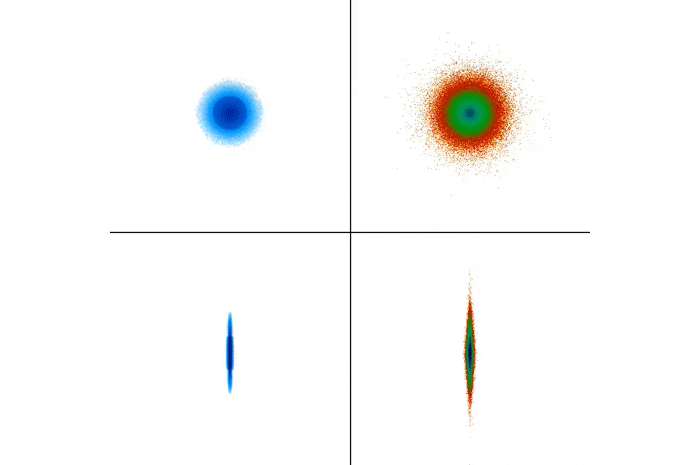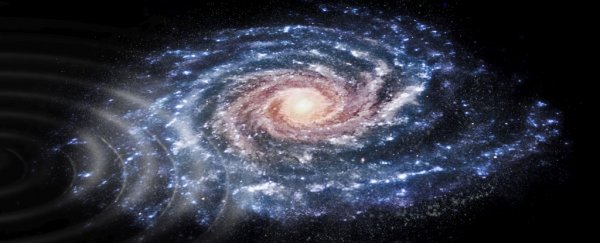Antlia 2, the "ghost of a galaxy" orbiting the Milky Way, is a dark horse in more ways than one. Not only is it so faint it was only just discovered last year, it may now be responsible for curious ripples in the hydrogen gas that makes up the Milky Way's outer disc.
According to new research, Antlia 2's current position is consistent with a collision with the Milky Way hundreds of millions of years ago that could have produced the perturbations we see today. The paper has been submitted for publication and is undergoing peer review.
Antlia 2 was a bit of a surprise when it showed up in the second Gaia mission data release last year. It's really close to the Milky Way - one of our satellite galaxies - and absolutely enormous, about the size of the Large Magellanic Cloud.
But it's incredibly diffuse and faint, and hidden from view by the galactic disc, so it managed to evade detection.
That data release also showed in greater detail ripples in the Milky Way's disc. But astronomers had known about perturbations in that region of the disc for several years by that point, even if the data wasn't as clear as that provided by Gaia.
It was based on this earlier information that, in 2009, astrophysicist Sukanya Chakrabarti of the Rochester Institute of Technology and colleagues predicted the existence of a dwarf galaxy dominated by dark matter in pretty much the exact location Antlia 2 was found nearly a decade later.
Using the new Gaia data, the team calculated Antlia 2's past trajectory, and ran a series of simulations. These produced not just the dwarf galaxy's current position, but the ripples in the Milky Way's disc by way of a collision less than a billion years ago.
 Simulation of the collision: The gas distribution is on the left, stars on the right. (RIT)
Simulation of the collision: The gas distribution is on the left, stars on the right. (RIT)
Previously, a different team of researchers had attributed these perturbations to an interaction with the Sagittarius Dwarf Spheroidal Galaxy, another of the Milky Way's satellites.
Chakrabarti and her team also ran simulations of this scenario, and found that the Sagittarius galaxy's gravity probably isn't strong enough to produce the effects observed by Gaia.
"Thus," the researchers wrote in their paper, "we argue that Antlia 2 is the likely driver of the observed large perturbations in the outer gas disk of the Galaxy."
Previous simulations run by the team that discovered Antlia 2 suggested that much of the dwarf galaxy's material has, over time, been absorbed via tidal interactions with the Milky Way. If the two collided, that's one possible way at least some material was transferred.
And, if the two collided, this will allow astronomers to trace the dwarf galaxy's history, which could shed some light on its dark matter profile. While most of the time dark matter tends to clump together in galactic centres, Antlia 2's extraordinary diffuseness could mean it's home to a different distribution.
And Chakrabarti's previous prediction was heavily reliant on the presence of dark matter.
"If Antlia 2 is the dwarf galaxy we predicted, you know what its orbit had to be. You know it had to come close to the galactic disc," she said.
"That sets stringent constraints, therefore, on not just on the mass, but also its density profile. That means that ultimately you could use Antlia 2 as a unique laboratory to learn about the nature of dark matter."
There's still a possibility that something else created the ripples, but the team has thought of that, too. Based on their reconstruction of past events, they predicted the future positions of the stars in Antlia 2.
The next Gaia data release is due in a year or two. If the data matches the team's predictions, it will add significant weight to the theory.
The research has been submitted to The Astrophysical Journal Letters, and has been published on arXiv.
